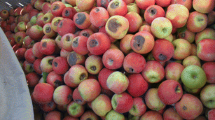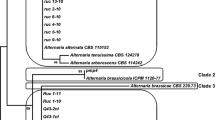Abstract
Four Alternaria species groups (A. longipes, A. arborescens, A. alternata/A. tenuissima and A. tenuissima/A. mali) are associated with leaf blotch and fruit spot of apple in Australia. There is no information on the variability of pathogenicity among the species and isolates within each species causing leaf blotch or fruit spot. We used a detached leaf assay and an in planta fruit inoculation assay to determine the pathogenicity and virulence of the four Alternaria species. Our results showed that isolates within the same species were not specific to either leaf or fruit tissue and showed great variability in pathogenicity and virulence, indicating cross-pathogenicity, which may be isolate dependent rather than species dependent. Generally, virulence of A. tenuissima and A. alternata isolates on leaf and fruit was higher than other species. Isolates of all species groups were pathogenic on leaves of different cultivars, but pathogenicity on fruit of different cultivars varied among isolates and species. Implications of our findings on prevalence of the diseases in different apple-producing regions in Australia and the development of targeted disease management of the diseases are discussed.



Similar content being viewed by others
References
Andersen, B., Kroger, E., & Roberts, R. G. (2002). Chemical and morphological segregation of Alternaria arborescens, A. infectoria and A. tenuissima species-groups. Mycological Research, 106, 170–182.
Belisario, A., Maccaroni, M., Coramusi, A., Corazza, L., Pryor, B. M., & Figuli, P. (2004). First report of Alternaria species groups involved in disease complexes of hazelnut and walnut fruit. Plant Disease, 88(4), 426–426.
Chennell, A., Bates, V., & Williams, D. (2002). Apple maturity management. (pp. 38). Melbourne: Department of Natural Resources and Environment.
Cordes, D. (1987). Vegetative and generative behaviour of apple trees after defoliation. Erwerbsobstbau, 29(8), 245–249.
Filajdic, N., & Sutton, T. B. (1991). Identification and distribution of Alternaria mali on apples in North Carolina and susceptibility of different varieties of apples to Alternaria blotch. Plant Disease, 75(10), 1045–1048.
Filajdic, N., & Sutton, T. B. (1995). Overwintering of Alternaria mali, the causal agent of Alternaria blotch of apple. Plant Disease, 79(7), 695–698.
Greco, M., Patriarca, A., Terminiello, L., Fernandez Pinto, V., & Pose, G. (2012). Toxigenic Alternaria species from Argentinean blueberries. International Journal of Food Microbiology, 154(3), 187–191.
Harteveld, D. O. C., Akinsanmi, O. A., & Drenth, A. (2013). Multiple Alternaria species groups are associated with leaf blotch and fruit spot diseases of apple in Australia. Plant Pathology, 62(2), 289–297.
Horlock, C. M. (2006). Management of Alternaria leaf and fruit spot in apples. Final Report Project AP02011. (pp. 76). Sydney: Horticulture Australia Limited.
Hu, J., Chen, C., Peever, T., Dang, H., Lawrence, C., & Mitchell, T. (2012). Genomic characterization of the conditionally dispensable chromosome in Alternaria arborescens provides evidence for horizontal gene transfer. BioMed Central Genomics, 13.
Johnson, R. D., Johnson, L., Kohmoto, K., Otani, H., Lane, C. R., & Kodama, M. (2000). A polymerase chain reaction-based method to specifically detect Alternaria alternata apple pathotype (A. mali), the causal agent of Alternaria blotch of apple. Phytopathology, 90(9), 973–976.
Konarska, A. (2012). Differences in the fruit peel structures between two apple cultivars during storage Acta Scientiarum Polonorum-Hortorum Cultus, 11(2), 105–116.
Kusaba, M., & Tsuge, T. (1994). Nuclear ribosomal DNA variation and pathogenic specialization in Alternaria fungi known to produce host specific toxins. Applied and Environmental Microbiology, 60(9), 3055–3062.
Leach, J. E., Cruz, C. M. V., Bai, J. F., & Leung, H. (2001). Pathogen fitness penalty as a predictor of durability of disease resistance genes. Annual Review of Phytopathology, 39, 187–224.
Logrieco, A., Moretti, A., & Solfrizzo, M. (2009). Alternaria toxins and plant diseases: an overview of origin, occurrence and risks. World Mycotoxin Journal, 2(2), 129–140.
Lloyd, H. L. (1969). Pathogenic stability of Alternaria longipes (Ell. and Ev.) Mason subjected to different methods of isolation, storage and inoculum production. Mycopathologia Et Mycologia Applicata, 38(1–2), 33–39.
Peever, T. I., Su, G., Carpenter-Boggs, L., & Timmer, L. W. (2004). Molecular systematics of citrus-associated Alternaria species. Mycologia, 96(1), 119–134.
Persley, D., & Horlock, C. M. (2009). Alternaria leaf blotch and fruit spot of apple. In T. Cooke, D. Persley, & S. House (Eds.), Diseases of Fruit Crops in Australia (pp. 31–32). Collingwood: CSIRO Publishing.
Pringle, A., & Taylor, J. W. (2002). The fitness of filamentous fungi. Trends in Microbiology, 10(10), 474–481.
Pryor, B. M., & Michailides, T. J. (2002). Morphological, pathogenic, and molecular characterization of Alternaria isolates associated with Alternaria late blight of pistachio. Phytopathology, 92(4), 406–416.
Roberts, J. W. (1924). Morphological characters of Alternaria mali Roberts. Journal of Agricultural Research, 27, 699–708.
Rotondo, F., Collina, M., Brunelli, A., & Pryor, B. M. (2012). Comparison of Alternaria spp. collected in Italy from apple with A. mali and other AM-toxin producing strains. Phytopathology, 102(12), 1130–1142.
Sawamura, K. (1962). Studies on spotted disease of apple 1. Causal agent of Alternaria blotch. Bulletin of the Tohoku National Agricultural Experiment Station, 23, 163–175.
Stewart, J. E., Thomas, K. A., Lawrence, C. B., Dang, H., Pryor, B. M., Timmer, L. M., & Peever, T. L. (2013). Signatures of recombination in clonal lineages of the citrus brown spot pathogen, Alternaria alternata sensu lato. Phytopathology, 103(7), 741–749.
Teviotdale, B. L., Viveros, M., Pryor, B., & Adaskaveg, J. E. (2001). First report of Alternaria leaf spot of almond caused by species in the Alternaria alternata complex in California. Plant Disease, 85(5), 558.
Wu, G., Wang, Y., Wang, P., Wang, J., & Gong, B. (1999). Study on the differentiation and biological characteristics of Alternaria alternata f. sp. mali. China Fruits, 4, 11–15.
Yoon, J. T., Lee, J. T., Park, S. D., & Park, D. O. (1989). Effects of meteorological factors on the occurrence of Alternaria leaf blotch caused by Alternaria alternata f. sp. mali. Korean Journal of Plant Pathology, 5(3), 312–316.
Acknowledgement
This work was funded by the Horticulture Australia Limited (Project AP06007) with levies from Australian apple and pear growers. The authors would like to thank Mr. Allan McWaters and Dr. Shane Dullahide for their assistance at the DAFF Applethorpe Research Station with providing potted trees and use of the orchards for the inoculation trials.
Author information
Authors and Affiliations
Corresponding author
Rights and permissions
About this article
Cite this article
Harteveld, D.O.C., Akinsanmi, O.A. & Drenth, A. Pathogenic variation of Alternaria species associated with leaf blotch and fruit spot of apple in Australia. Eur J Plant Pathol 139, 789–799 (2014). https://doi.org/10.1007/s10658-014-0433-6
Accepted:
Published:
Issue Date:
DOI: https://doi.org/10.1007/s10658-014-0433-6




